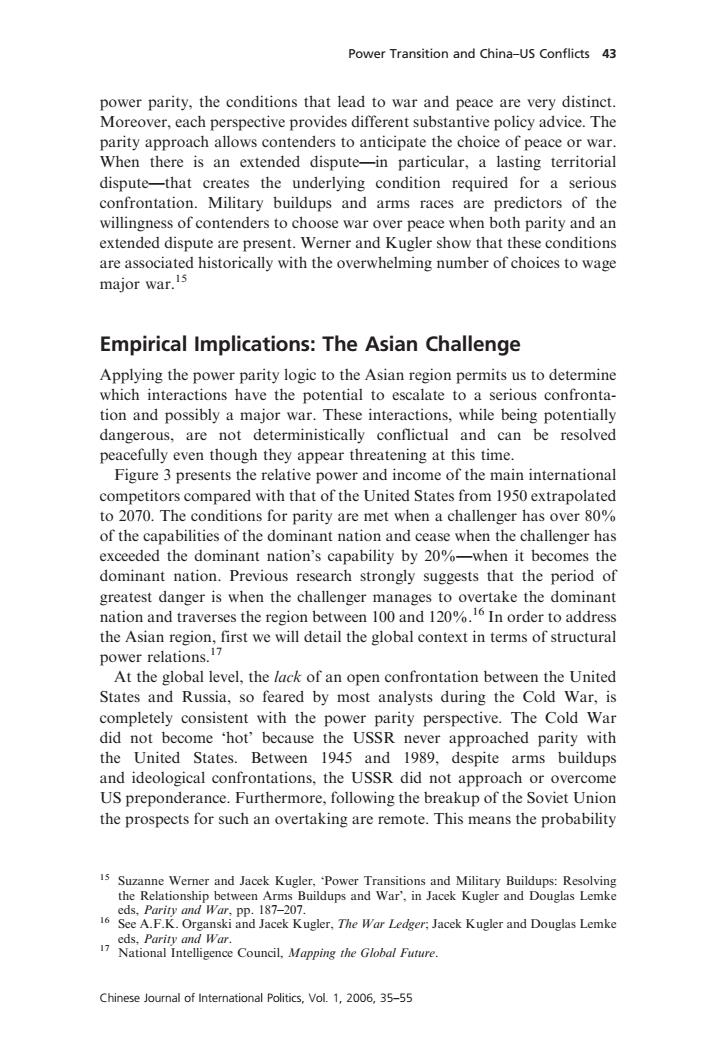正在加载图片...

Power Transition and China-US Conflicts 43 power parity,the conditions that lead to war and peace are very distinct. Moreover,each perspective provides different substantive policy advice.The parity approach allows contenders to anticipate the choice of peace or war. When there is an extended dispute-in particular,a lasting territorial dispute-that creates the underlying condition required for a serious confrontation.Military buildups and arms races are predictors of the willingness of contenders to choose war over peace when both parity and an extended dispute are present.Werner and Kugler show that these conditions are associated historically with the overwhelming number of choices to wage major war.is Empirical Implications:The Asian Challenge Applying the power parity logic to the Asian region permits us to determine which interactions have the potential to escalate to a serious confronta- tion and possibly a major war.These interactions,while being potentially dangerous,are not deterministically conflictual and can be resolved peacefully even though they appear threatening at this time. Figure 3 presents the relative power and income of the main international competitors compared with that of the United States from 1950 extrapolated to 2070.The conditions for parity are met when a challenger has over 80% of the capabilities of the dominant nation and cease when the challenger has exceeded the dominant nation's capability by 20%-when it becomes the dominant nation.Previous research strongly suggests that the period of greatest danger is when the challenger manages to overtake the dominant nation and traverses the region between 100 and 120%.6 In order to address the Asian region,first we will detail the global context in terms of structural power relations.17 At the global level,the lack of an open confrontation between the United States and Russia,so feared by most analysts during the Cold War,is completely consistent with the power parity perspective.The Cold War did not become 'hot'because the USSR never approached parity with the United States.Between 1945 and 1989,despite arms buildups and ideological confrontations,the USSR did not approach or overcome US preponderance.Furthermore,following the breakup of the Soviet Union the prospects for such an overtaking are remote.This means the probability is Suzanne Werner and Jacek Kugler.'Power Transitions and Military Buildups:Resolving the Relationship between Arms Buildups and War',in Jacek Kugler and Douglas Lemke eds,Pariry and War,pp.187-207. 16 See A.F.K.Organski and Jacek Kugler,The War Ledger:Jacek Kugler and Douglas Lemke eds,Parity and War. National Intelligence Council,Mapping the Global Future. Chinese Journal of International Politics,Vol.1,2006,35-55power parity, the conditions that lead to war and peace are very distinct. Moreover, each perspective provides different substantive policy advice. The parity approach allows contenders to anticipate the choice of peace or war. When there is an extended dispute—in particular, a lasting territorial dispute—that creates the underlying condition required for a serious confrontation. Military buildups and arms races are predictors of the willingness of contenders to choose war over peace when both parity and an extended dispute are present. Werner and Kugler show that these conditions are associated historically with the overwhelming number of choices to wage major war.15 Empirical Implications: The Asian Challenge Applying the power parity logic to the Asian region permits us to determine which interactions have the potential to escalate to a serious confrontation and possibly a major war. These interactions, while being potentially dangerous, are not deterministically conflictual and can be resolved peacefully even though they appear threatening at this time. Figure 3 presents the relative power and income of the main international competitors compared with that of the United States from 1950 extrapolated to 2070. The conditions for parity are met when a challenger has over 80% of the capabilities of the dominant nation and cease when the challenger has exceeded the dominant nation’s capability by 20%—when it becomes the dominant nation. Previous research strongly suggests that the period of greatest danger is when the challenger manages to overtake the dominant nation and traverses the region between 100 and 120%.16 In order to address the Asian region, first we will detail the global context in terms of structural power relations.17 At the global level, the lack of an open confrontation between the United States and Russia, so feared by most analysts during the Cold War, is completely consistent with the power parity perspective. The Cold War did not become ‘hot’ because the USSR never approached parity with the United States. Between 1945 and 1989, despite arms buildups and ideological confrontations, the USSR did not approach or overcome US preponderance. Furthermore, following the breakup of the Soviet Union the prospects for such an overtaking are remote. This means the probability 15 Suzanne Werner and Jacek Kugler, ‘Power Transitions and Military Buildups: Resolving the Relationship between Arms Buildups and War’, in Jacek Kugler and Douglas Lemke eds, Parity and War, pp. 187–207. 16 See A.F.K. Organski and Jacek Kugler, The War Ledger; Jacek Kugler and Douglas Lemke eds, Parity and War. 17 National Intelligence Council, Mapping the Global Future. Power Transition and China–US Conflicts 43 Chinese Journal of International Politics, Vol. 1, 2006, 35–55